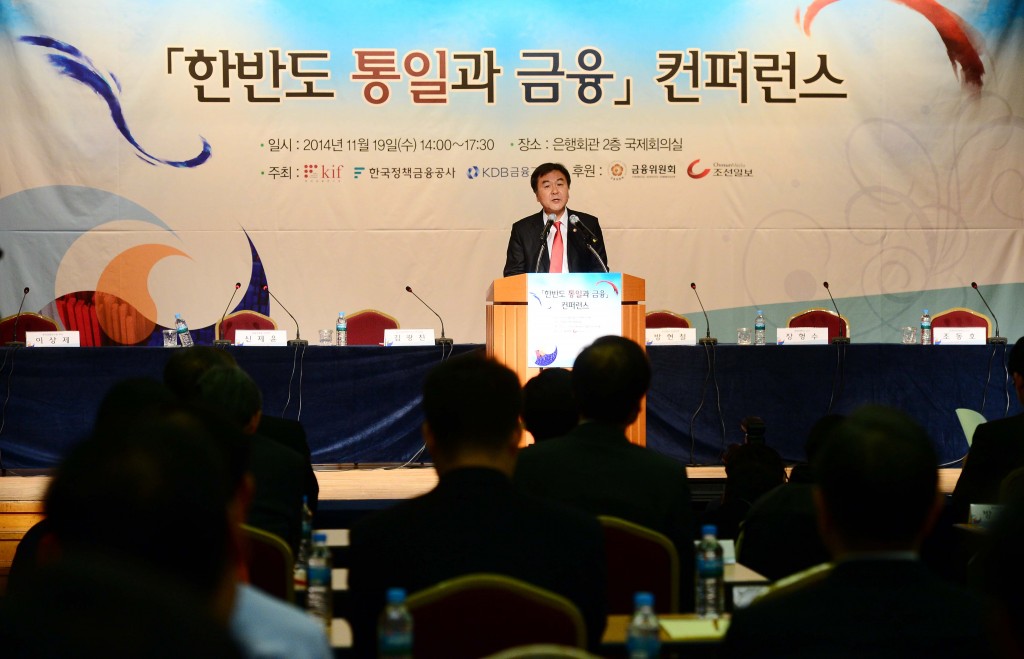- California Assembly OKs highest minimum wage in nation
- S. Korea unveils first graphic cigarette warnings
- US joins with South Korea, Japan in bid to deter North Korea
- LPGA golfer Chun In-gee finally back in action
- S. Korea won’t be top seed in final World Cup qualification round
- US men’s soccer misses 2nd straight Olympics
- US back on track in qualifying with 4-0 win over Guatemala
- High-intensity workout injuries spawn cottage industry
- CDC expands range of Zika mosquitoes into parts of Northeast
- Who knew? ‘The Walking Dead’ is helping families connect
S. Korea to raise $500 billion for unification

FSC Chairman Shin Je-yoon talks about a financial blueprint for a future North-South unification. (NEWSis)
SEOUL (Yonhap) — South Korea plans to raise US$500 billion largely from the public sector, without raising taxes, to help North Korea prepare for a future reunification, the top financial regulator said Tuesday.
In a financial blueprint for a future North-South unification, the Financial Services Commission (FSC) said an estimated $500 billion is needed to raise North Korea’s gross domestic product (GDP) per capita from $1,251 in 2013 to $10,000 within 20 years after a possible unification.
It will also spend an additional $175 billion on infrastructure and industrial development, it added.
North Korea’s GDP totaled 34 trillion won ($31 billion) as of end-2013, a level equivalent to that of South Korea in 1971 and a mere 2 percent of the South’s GDP in 2013.
The South’s GDP was 42.5 times higher than the North’s in 2013, much higher than the 9.7-fold difference between West Germany and East Germany ahead of their 1990 unification.
The FSC said state-run policy financing agencies, including the Korea Development Bank (KDB) and Korea Exim Bank, will play a major role in raising the funds, as Germany’s government-owned development bank, or the KfW, did 24 years ago.
The state agencies will take responsibility for up to 60 percent of the total expenses by running development projects in North Korea, while the rest will be raised by collecting overseas development aid (ODA) and private and public investments.
“In the initial stage of unification, the government will lead the North Korean development by using state funds and projects, and then the ODA and private investments can be utilized,” said FSC Chairman Shin Je-yoon.
The FSC suggested the introduction of a commercial banking system and the establishment of a policy financing body to pursue stable economic integration between the two countries.
It also noted that currency conversion is the most sophisticated issue in unification as the exchange rate would be largely conditioned on political negotiations and social consensus.
“We have to consider many factors, including the economic gap between the two countries and macroeconomic variables before introducing a currency system to the North,” said Shin. “The monetary integration should be decided after comprehensive discussion.”
East German currency was exchanged for West German deutsche marks at a rate of 1 to 1, although the market rate was 4 to 1, according to the FSC.
The overestimated currency conversion helped stabilize the livelihoods of workers from East Germany in the short term, but soon resulted in a sudden wage hike, which damaged the profitability of East German companies.












![일본 사도광산 [서경덕 교수 제공. 재판매 및 DB 금지]](http://www.koreatimesus.com/wp-content/uploads/2024/07/PYH2024072610800050400_P4-copy-120x134.jpg)


